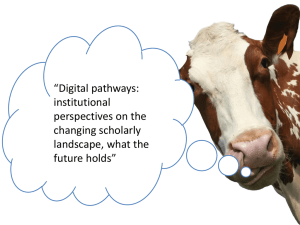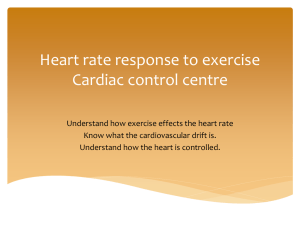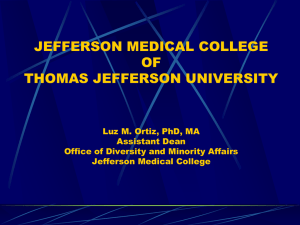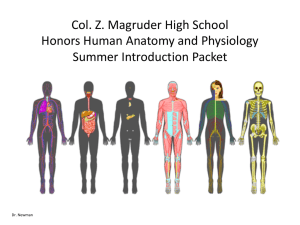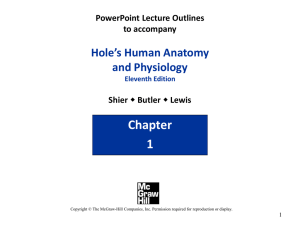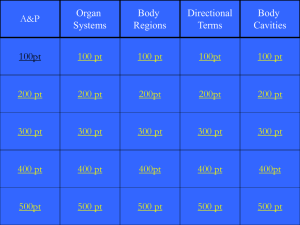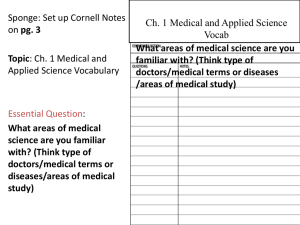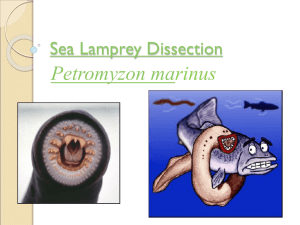HISTORY
advertisement
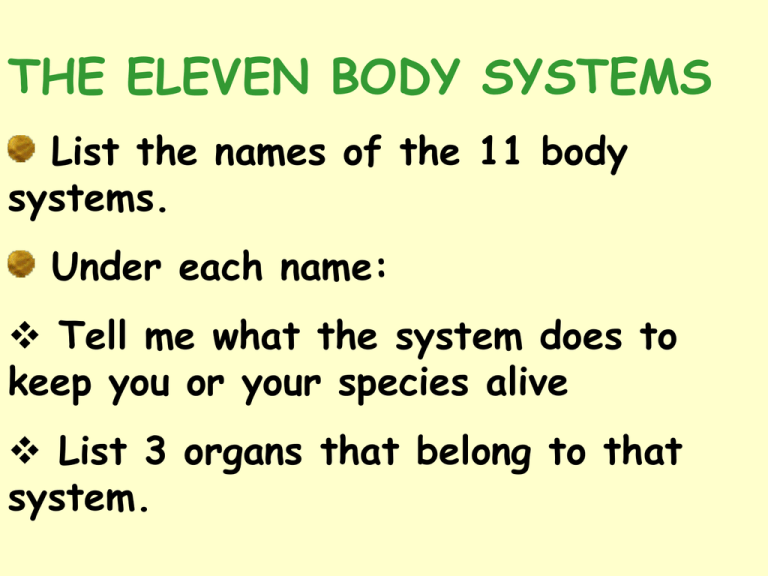
THE ELEVEN BODY SYSTEMS List the names of the 11 body systems. Under each name: Tell me what the system does to keep you or your species alive List 3 organs that belong to that system. Introduction to Anatomy and Physiology What is Anatomy & Physiology? • Anatomy = “cutting up” (Greek) – The study of the structure and form of the parts of a living organism – Example: What does the heart look like & what are some of its parts? • Physiology – The study of the function of the parts of an organism – Example: What does the heart do for the body? Three Levels of Anatomy • Gross – anatomy on a large scale – Example: Learning the names of the bones and certain regions on them • Histology – anatomy at the tissue level – Example: What is bone tissue made of? • Cytology – anatomy at the cellular level – Example: What types of cells make up bone tissue? HISTORY OF ANATOMY, PHYSIOLOGY, AND MEDICINE Primitive Times • Believed that illness and diseases were a punishment from the Gods • First physicians were witch doctors who treated illness with ceremonies Primitive Times • Herbs and plants were 1st pharmaceuticals Examples: Foxglove gave digitalis plants – leaves were chewed to strengthen & slow heart – Now given by pills, IV, or injections Primitive Medicine •Quinine is from the bark of the cinchona tree. Quinine is used alone or with other medications to treat malaria • Atropine is derived from the belladonna plant. It is used to relax muscles by inhibiting nerve responses. It is alos used to dilate the pupils and as an antispasmodic. •Morphine is derived from opium from the poppy plant. It is a narcotic pain reliever used to treat moderate to severe pain Trepanation • One of the first surgeries • A hole was cut into the skull to release demons • What are some of the possible complications of this treatment? History of Anatomy-Egypt (3000 BC- 300 BC) • Early references to anatomy from ancient Egypt (1500 BC) • Came from practice of mummifying their dead • Egyptians believed the liver to be a part of the soul that formed the seat of thought & feeling 3500 year old Egyptian Mummy Egyptians • • • • First to keep accurate health records Wrote prescriptions on papyrus Physicians were priests Temples were used as places of worships, medical schools, and hospitals Egyptians (3000 BC- 300 BC) • Leeches would be use for bloodletting (draining human blood) • Does not hurt because their saliva contains a natural anesthetic • Their saliva also contains a blood thinner, a vasodilator, and an agent that prevents bacteria from infecting the wound • FDA has recently approved use of leeches as a medical treatment (more about this later) Ancient Chinese (1700 BC–AD 220) • Religion prohibited dissection • Believed you had to treat both the body and spirit • Recorded a pharmacopoeia of medications based on herbs • Therapies included acupuncture Alternative Medicine – much based on Chinese and Asian culture This will be covered in greater detail later. Greeks (1200 BC –200 BC) • Made observations about the human body and the effects of disease that led to modern medical sciences • Believed illness is a result of natural causes History of Anatomy (Greece) The Greeks were the first to attempt to study objectively the human body. That is why many medical terms are based on the Greek lanquage. Greeks • Used therapies such as massage, art therapy and herbal treatments • Discovered that diet and cleanliness could prevent disease The Two Great Names in the History of Greek Medicine • Hippocrates-dominated the beginning of a period of remarkable scientific creativity, which lasted more than 700 years • Galen—near the end of the period, both furthered scientific knowledge and crystallized it in an amazing volume of written works. His influence lasted for 1500 years/45 generations. Hippocrates(460B.C.-377B.C.) • Hippocrates is know as the “Father of Medicine.” He is considered one of the greatest physicians the world has ever known. • He was the first to attempt to separate the practice of medicine from religion and superstition. • Hippocrates developed his pledge of proper conduct for doctors. “I will use treatment to help the sick according to my ability and judgment, but never with the view to injury and wrong doing…Into whatsoever houses I enter, I will enter to help the sick.” History of Anatomy (Greece) – Believed that air flowed into the heart History of Anatomy (Greece) • Hippocrates http://encyclopedia.thefr eedictionary.com/four%2 0humors – Notion of the four humors History of Anatomy (Greece) Hippocrates - THE FOUR HUMORS • Blood was thought to come from the heart • Phlegm from the brain • Yellow bile from the liver • Black bile from the spleen The Greeks believed that a person would be healthy if these humors were in balance. The 4 Humors coincided with the four elements recognized by the Greeks The temperaments are sanguine (pleasureseeking and sociable), choleric (ambitious and leader-like), melancholic (introverted and thoughtful), and phlegmatic (relaxed and quiet). Figure 1. Early Greek Model of Elements & Humors History of Anatomy (Greece) • Hippocrates - The foundation of the principles of medical ethics. - Hippocrates was the first to separate medicine from philosophy and disprove the idea that disease was a punishment for sin. History of Anatomy (Greece) • Hippocrates – 460-377 BC – Father of Medicine – gives his name to the Hippocratic oath that doctors take. – Air flowed into the heart – Notion of the four humors More on Bloodletting…….. • The practice of bloodletting seemed logical when the foundation of all medical treatment was based on the four body humors: blood, phlegm, yellow bile, and black bile. • Health was thought to be restored by purging, starving, vomiting or bloodletting Bloodletting is one of the oldest medical practices, having been practiced among ancient peoples including the Egyptians and the Greeks. Bloodletting 15th Century Text book of Bloodletting The barber poles that we may still see today are a result of these ancient blood letting practices. By the middle ages, both surgeons and barbers were specializing in this bloody practice. Barbers advertised their blood letting practices with a red (for blood) and white (for tourniquet) striped pole. The pole itself represented the stick squeezed by the patient to dilate the veins. By the end of the 19th century (1875-1900), phlebotomy was declared quackery. http://www.pb s.org/wnet/red gold/basics/ba rbersurgeons. html Did blood letting lead to the final demise of our 1st president? On December 14, 1799, George Washington contracted an illness that inflamed his throat. His health deteriorated rapidly. Doctors tried to treat him by bloodletting, a common medical procedure during this time period for most types of ailments. After being drained of 3.75 liters of blood within 24 hours, his illness and the bloodletting weakened him, and he died later that same day. (Adults have 5.6 liters of blood) Leeches and Bloodletting Most people today regard leeches as disgusting, but for centuries these blood-sucking creatures were a mainstay of medical care. Derived from the Anglo-Saxon word loece, to heal (Medieval doctors called themselves leeches). The leech was used as an adjunct to bloodletting, in places too sensitive or confined for the lancet or other blood-letting instruments. Physicians applied leeches to areas such as "the gums, lips, nose,and fingers“. Leeches became popular in the 19th century -- so much so that the species became endangered in Europe. In 1833 alone, French doctors imported 41,500,000 leeches. Eventually the procedure was largely abandoned, along with other forms of bloodletting. The leech was indispensable in 19th Century medicine for bloodletting, a practice believed to be a cure for anything from headache to gout. As the use of leeches increased many pharmacists became responsible for their care and dispensation. Today leeches have found renewed utility in certain surgical procedures, particularly after microsurgery. Doctors sometimes find it helpful, for example, to use leeches to restore circulation to a re-attached finger or other small body parts, or to portions of the skin following plastic surgery. Leeches Used in Medicine Successful reattachment of severed ear, as blood continued to flow and carry nutrients to the damaged region Cupping Cupping is an ancient Chinese practice that involves placing a cup over the skin and using fire or suction to create a vacuum within the cup which draws the skin and superficial muscle layer into the cup. The theory behind cupping is that it increases the blood flow and lymphatic drainage in the areas being treated and therefore promotes healing. It is also thought that cupping can help to reexpand the lungs in disease states. Back to the History of Anatomy and Physiology …. History of Anatomy (Greece) • Aristotle –Contemporary of Hippocrates History of Anatomy (Greece) • Aristotle -Along with his contemporary scientistphilosophers, Aristotle thought arteries contained air and veins carried blood. He had other "strange" ideas but was roughly accurate as far as the general anatomy of the human body. -Recognized that bodies are made of parts, which in turn are made of simpler parts History of Anatomy (Greece) • Aristotle - Recognized that similar organs in different organisms probably have similar functions - Thought the brain cooled the body and the heart heated it - Thought that the heart was the location of the mind, will, and emotions History of Anatomy (Greece) • Herophilus - Father of Anatomy – Founded first school of anatomy – Encouraged the use of dissection in the study of anatomy – Identified heart as the origin of the human pulse History of Anatomy (Rome) Human dissections were forbidden during this time in Rome • Galen – 129-201 AD – Proved that arteries carry blood and not air – Believed that blood originated in the liver and flowed outwards to form the flesh Dark Ages Dark and Middle Ages - Medicine was practiced only in monasteries and convents. - The greatest contribution was the collection and translation of the works of Greek and Roman physicians. - Sanitation was forgotten in this period and resulted in the spread of serious communicable diseases. - The bubonic plague (the Black Death). History of Anatomy Arabic Medicine • From the fall of Rome until the European Renaissance of the 15th century, the Islamic world was the center of medical knowledge. • Greek medical texts were translated into Arabic and augmented with sophisticated pharmaceutical information History of Anatomy Arabic Medicine •From the fall of Rome until the European Renaissance of the 15th century, the Islamic world was the center of medical knowledge. •Greek medical texts were translated into Arabic and augmented with sophisticated pharmaceutical information •Many herbs and spices like nutmeg, cloves, and mace were not originally valued as cooking ingredients, but as medicines The Renaissance Period The Renaissance Period •Universities and medical schools were founded, providing a formal environment for research and instruction. •Previously existing beliefs were challenged, and exploration began on new horizons of human understanding. •The printing press was invented, promoting a much more rapid dissemination of information. •Stigma attached to dissection of the dead was overcome, allowing advancement of knowledge in anatomy and physiology History of Anatomy (Renaissance) • Period of renewed interest in science and the arts • 14th & 15th century • Mondino de Luzzi – Italian scholar known as the restorer of anatomy – Wrote Anathomia, considered best work on anatomy at the time History of Anatomy (Renaissance) • Andreas Vesalius – Father of modern anatomy – Published first complete textbook – Identified heart as center of vascular network History of Anatomy (Renaissance) • Vesalius was one of the first to dissect cadavers himself (rather than rely on others or on animal dissections) • Even Leonardo da Vinci and other "artistanatomists" didn't do their own dissection (of course, they lived nearly twice as long because they weren't exposed to infections in the dead bodies) History of Anatomy (Renaissance) • Vesalius was obsessed with dissections, even stacking up cadavers in his bedroom as a medical student in Paris. • Later in his life, he told his students to keep a list of their really sick patients so he'd know where to go to get a freshly dead body. History of Anatomy (Renaissance) • Leonardo da Vinci –Took a particular interest in anatomical drawings as an art form Some of Leonardo’s Works William Harvey (1578-1657) - Showed that the heart is a double pump and how blood actually circulates. - Harvey is credited with beginning modern physiological research and experimentation TOOLS THAT HAVE IMPROVED THE STUDY OF ANATOMY TOOLS THAT HAVE IMPROVED THE STUDY OF ANATOMY, PHYSIOLOGY, & LEARNING ABOUT THE HUMANB BODY BRAINSTORM WITH YOUR NEIGHBOR List 6 important tools in the field of medicine, physiology and anatomy. Improved microscopy http://www.youtube.c om/watch?v=M4o0DxBgZk READ PAGES 56 – 57 DEALING WITH CAT SCANS PET scanners •PET stands for Positron Emission Tomography. •This is a fairly new type of scan that can show how body tissues are working and not just what they look like. •A PET scan can show the difference between scar tissue and active cancer tissue. http://www.youtube.com/watch?v=QZ Qq7chGoO4 PET produces images of the body by detecting the radiation emitted from radioactive substances. These substances are injected into the body, and are usually tagged with a radioactive atom. READ * PAGE 55 DEALING WITH RADIOISOTOPES * PAGES 70-71 DEALING WITH CT & PET SCANS http://www.youtube.com/watch?v=QZQq7chGoO4 •A PET scan demonstrates the biological function of the body before anatomical changes take place, while the CT scan provides information about the body's anatomy such as size, shape and location. •By combining these two scanning technologies, a PET/CT scan enables physicians to more accurately diagnose and identify cancer, heart disease and brain disorders. IMAGE FUSION Utilizing a dedicated imaging workstation, we are able to overlay PET data with CT/MRI images, allowing precise localization of tumor CT/MRI PET http://video.about.co m/orthopedics/MRI.h tm READ PAGES 6 – 7 DEALING WITH MRI http://www.youtube.com/watch?v=t _721QwF9V8 ENDOSCOPY - A thin, lighted tube used to look at tissues inside the body. http://video.about.com/heart burn/Heartburn-Reflux-Endoscopy.htm ENDOSCOPY A wireless endoscopy system in a capsule provides real-color images of the GI tract after the patient swallows the device. http://www.bing.com/videos/search ?q=pill+camera&FORM=HDRSC3 #view=detail&mid=4F4098177AE 2E7664DF84F4098177AE2E7664 DF8 http://www.bing.com/videos/search ?q=pill+camera&FORM=HDRSC3 #view=detail&mid=C748F7D699E A0C8E7D6EC748F7D699EA0C8E 7D6E ROBOTIC SURGERY http://www.youtube.com/watch?v= o76RnPJhg7w ORGAN AND BODY DONATION http://www.cnn.com/2010/HEALTH/10/28/body.after.you. die/index.html http://www.bodyworlds.com/index.html http://www.npr.org/templates/story/story.php?storyId=5553329 http://www.bing.com/videos/search?q=body+worlds&FORM=HD RSC3#view=detail&mid=2D6466031DFFF9B13EE62D6466031D FFF9B13EE6 And now for the ultimate body donation THE BODY FARM The first body farm (officially known as the University of Tennessee Forensic Anthropology Facility) was opened in 1971. Bass recognized the need for research into human decomposition after police repeatedly asked for his help analyzing bodies in criminal cases. http://www.bing.com/videos/search?q=BODY+FARM&FORM=H DRSC3#view=detail&mid=5283BBA0B15783CEC1C45283BBA 0B15783CEC1C4
